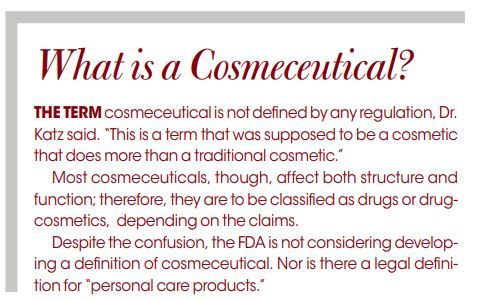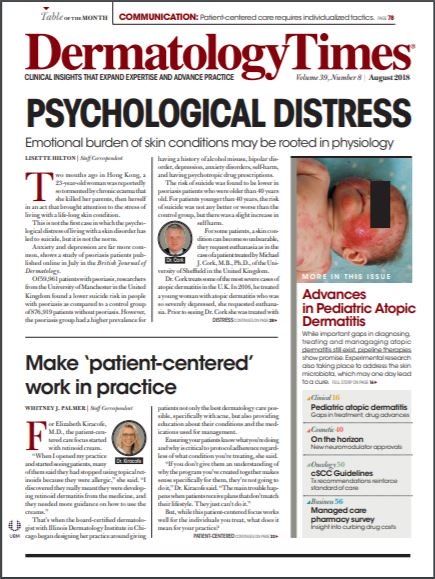- Case-Based Roundtable
- General Dermatology
- Eczema
- Chronic Hand Eczema
- Alopecia
- Aesthetics
- Vitiligo
- COVID-19
- Actinic Keratosis
- Precision Medicine and Biologics
- Rare Disease
- Wound Care
- Rosacea
- Psoriasis
- Psoriatic Arthritis
- Atopic Dermatitis
- Melasma
- NP and PA
- Skin Cancer
- Hidradenitis Suppurativa
- Drug Watch
- Pigmentary Disorders
- Acne
- Pediatric Dermatology
- Practice Management
- Prurigo Nodularis
- Buy-and-Bill
Publication
Article
Dermatology Times
Is it time to regulate probiotics in cosmetics?
Author(s):
The Food and Drug Administration is in the process of evaluating scientific data on the safety of probiotics and postbiotics in cosmetics, said Linda Katz, M.D., director of the Office of Cosmetics and Color for the FDA.
The Food and Drug Administration is in the process of evaluating scientific data on the safety of probiotics and postbiotics in cosmetics, said Linda Katz, M.D., director of the Office of Cosmetics and Color for the FDA.(©DusanPetkovic/Shutterstock.com)

The Food and Drug Administration is in the process of evaluating scientific data on the safety of probiotics and postbiotics in cosmetics, said Linda Katz, M.D., director of the Office of Cosmetics and Color for the FDA.
In speaking at the Skin Microbiome Congress in Boston in May, Dr. Katz, said that although probiotics may have actual live microorganisms, the FDA currently does not have a position on the use of probiotics or postbiotics in cosmetics. Probiotics is a multi-billion dollar industry estimated to grow 7 percent globally in the coming years. Topical cosmetics with probiotics is of particular interest to manufacturers and is rapidly growing area in cosmetics.
According to the Global New Products Database, the use of probiotics has grown exponentially since 2004 when there was no new production to 2017 when its use in skin care products, shower products, hair products, deodorants and color cosmetics skyrocketed.
But what consumers may not realize, Dr. Katz says, is that 90 percent of cosmetic products that carry “probiotic labels” actually have “postbiotics,” which consists of metabolic byproducts from probiotics.
To date, there is no legal definition of probiotics in the United States, but published studies have reported that probiotics can change the composition and function of the microbiome, which is distinct at each site. Probiotics have been proposed to be used as a strategy to promote microbial diversity, but when added to products, there is concern that the use of probiotics will change the existing microbiome of the skin.
Other unknowns Dr. Katz raised in her presentation include:
• Are probiotics still alive in the cosmetics that have preservatives?
• Does the presence of probiotics have an effect on product safety?
• Is there an effect on product quality?
• What are the intended functions of probiotics in cosmetics?
• Are there special considerations for manufacturing cosmetics containing probiotics?
• How can cosmetics containing live microorganisms meet existing microbial contamination limits?
• Does the presence of probiotics in cosmetics affect the shelf life and storage products?
• How are probiotic cosmetics regulated by other countries?
And while many countries, including the United States, have moved to adopt regulations for probiotic use in foods and biotherapeutic pharmaceuticals, there are no regulations in the U.S. or abroad, or even international guidelines on the regulation of probiotics in cosmetics. Another need, she said, is the harmonization of standards in the U.S., Canada and the European Countries.

EXISTING LAWS AND PRACTICES
In her presentation, Dr. Katz reviewed existing laws and recommended practices for cosmetic manufacturing.
First, the FDA does not have any premarket authority, only limited postmarket authority over cosmetics, she said. “However, prior to marketing, companies or individuals who manufacture or market cosmetics have a legal responsibility to ensure the safety of their products. The law does not require specific tests to demonstrate safety of the individual products or ingredients, and the law does not require that these products be sterile, or for the companies to share this information with the FDA,” she said. However, the law does prohibit adulterated and misbranded cosmetics.
In manufacturing cosmetics, there are no required good manufacturing practices (GMPs). “It is by guidance only. Manufacturers are not required to register their product. It is strictly voluntary. Adverse event reporting is also voluntary,” she said.
When a product is considered both a cosmetic and a drug, such as anti-dandruff shampoo, antimicrobial cleansers, antiperspirant deodorant or anticaries toothpaste, producers must abide by drug regulations by registering the product, following GMPs and reporting serious adverse events.
The Federal Food, Drug, and Cosmetic Act (FD&C) defines a cosmetic as a product that cleanses, beautifies, promotes attractiveness or alters appearance. Whereas it defines a drug as a product that is used to treat, prevent or mitigate disease in a way that affects the structure of function of the body.
“When using either a cosmetic or a drug, it is important that if an adverse event occurs, that it be reported to the FDA, especially for cosmetics,” Dr. Katz says. “This will help guide us in where our priorities need to lie and how we devote our resources to ensure that only safe products remain on the marketplace.”
“If a clinician is selling a product that is making drug claims, that product needs to be evaluated for efficacy and safety under the FDA drug regulations,” Dr. Katz states.
When a product falls under both a drug and cosmetic classification, it will require premarket approval through a new drug route or existing monograph. “For those drugs falling under the monograph, there are strict guidelines as to what ingredients can be included in these products and how these products are to be labeled,” Dr. Katz says.
In most cases, there are rules as to how the active and excipient ingredients can be mixed and matched, and for what purposes the drug can be marketed.
WHAT IS A COSMECEUTICAL?
The term cosmeceutical is not defined by any regulation, she said. “This is a term that was supposed to be a cosmetic that does more than a traditional cosmetic.”
Most cosmeceuticals, though, affect both structure and function; therefore, they are to be classified as drugs or drug-cosmetics, depending on the claims.
Despite the confusion, the FDA is not considering developing a definition of cosmeceutical. Nor is there a legal definition for “personal care products.”






